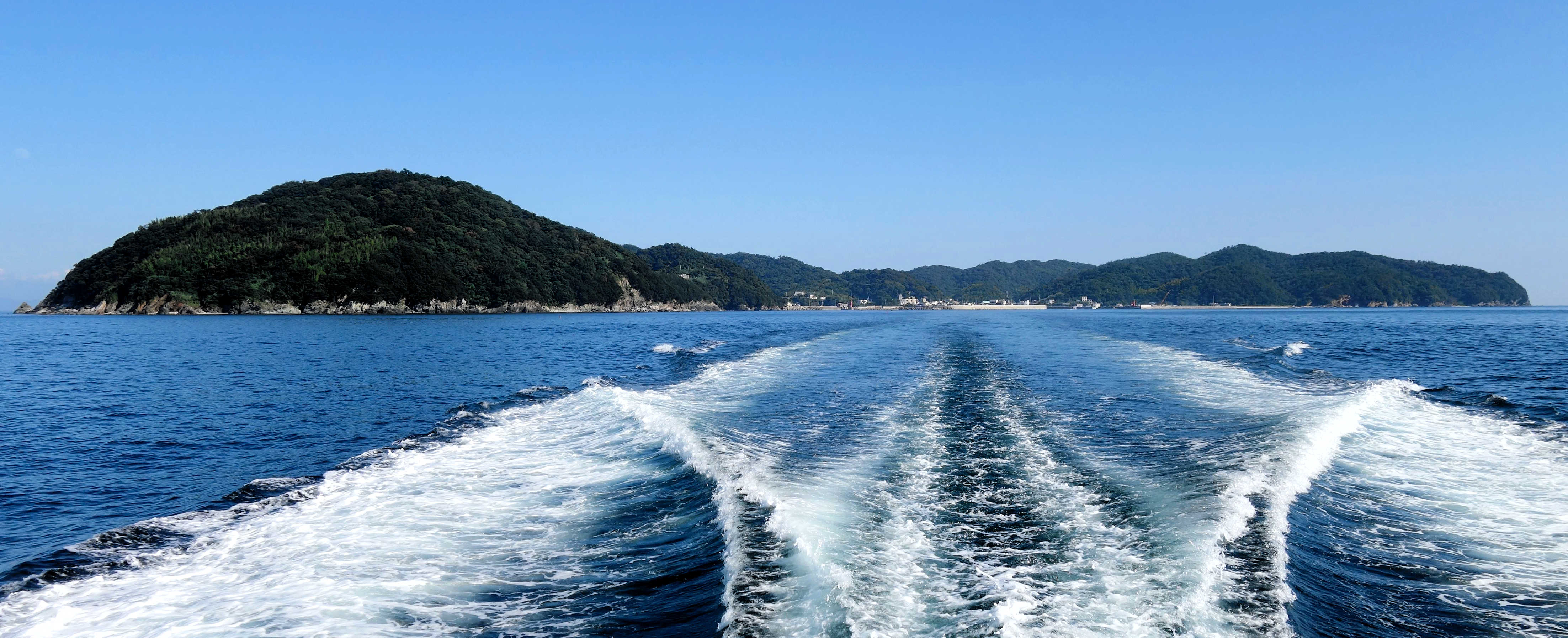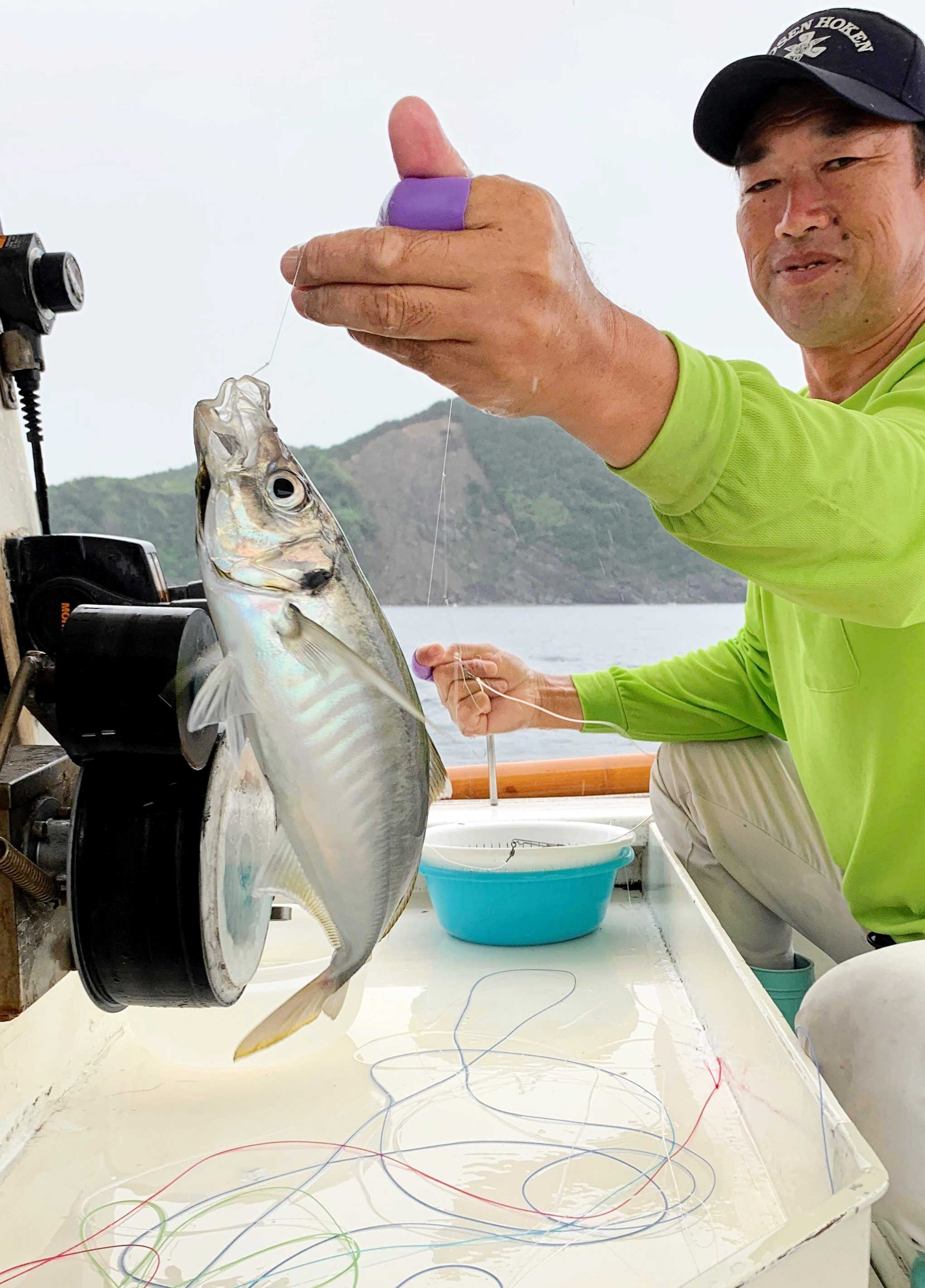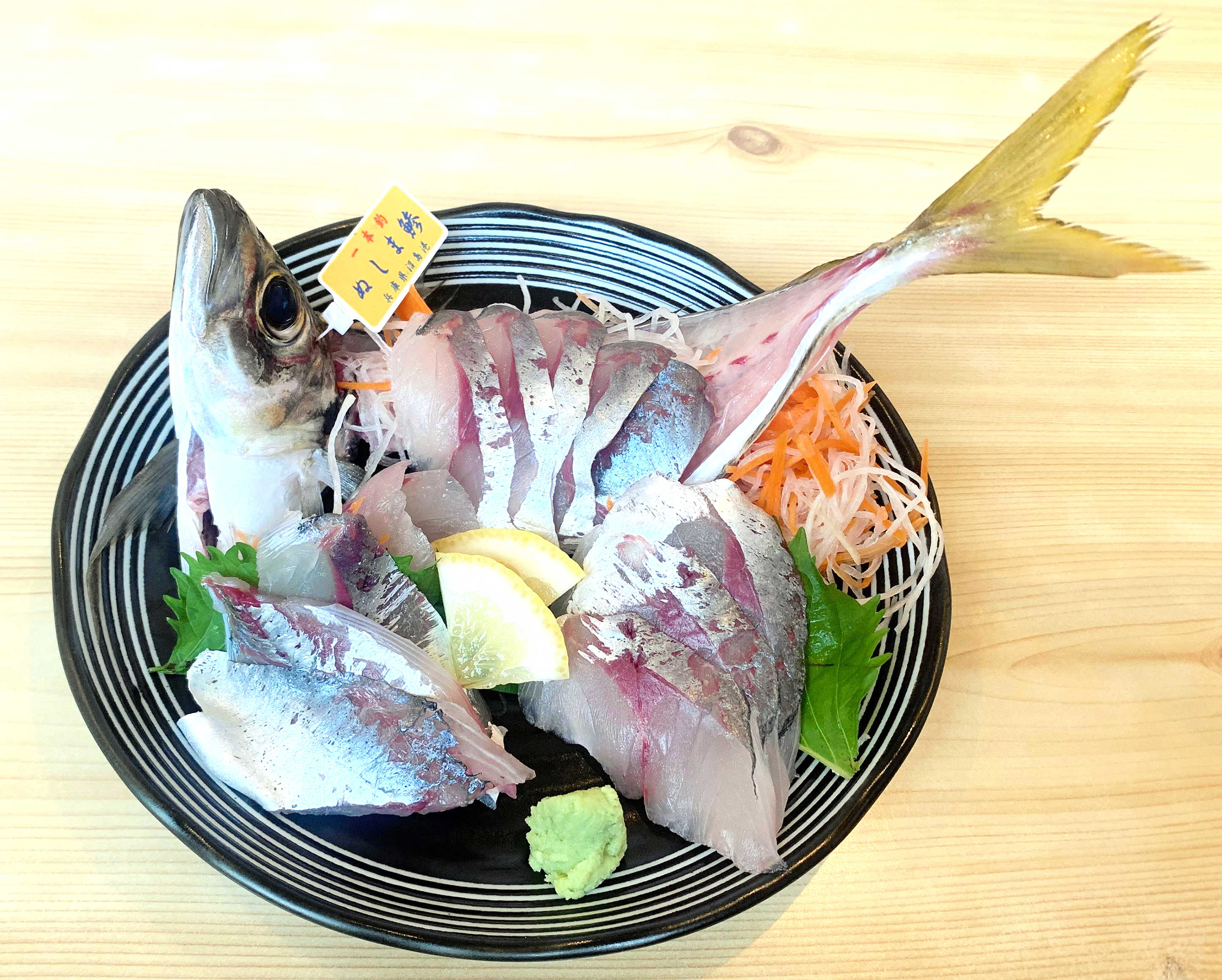Nushima Horse Mackerel Protection Through Handline Fishing, The Golden Fish
“Got a bite!” As light rain falls in the early morning, Kazuo Ishii, fishing with a single line, checks the tension with his fingertips and pulls up the line. Hooked on the end is a large, plump horse mackerel. “On sunny days, its body shines,” he says. He uses a tool to remove the hook from its mouth, and the fish slides down the pipe into the tank. This set-up allows him to catch fish without ever having to touch them, helping to avoid any possible damage. In this article, we bring you the story of horse mackerel from Nushima, Minami-Awaji City.

Nushima, said to resemble magatama. Some say it is the “Onokoro Island” from the legend of the birthplace of Japan.
Nushima is an island with a circumference of about 10 km, located 4 km south of Awaji Island. To the west is the Naruto Strait, famous for its whirlpools, to the east is the Kitan Strait, and to the south stretches the Kii Channel, which connects to the Pacific Ocean. The Median Tectonic Line, which extends from Kanto to Kyushu, runs between Nushima and Awaji Island, and the geology of Nushima is completely different from that north of Awaji Island. The island is rich in geomorphological and geological resources, with green and red crystalline schist, and is home to the world's rare "sheath folds" and Kamitategami Rock, which legends say may be the birthplace of Japan.
The Nushima Steamship makes 10 trips a day to and from Habu Port on Awaji Island. The island has a population of about 400, of which nearly 100 are fishermen. Along with sea bream and pike conger, the islands pride and joy is its ki-aji, or “golden” horse mackerel. The fishing season is from April to September.
Fat “Setsuki Horse Mackerel”
The common horse mackerels, called aji in Japanese, that are usually eaten swim in large schools, chasing their prey. Their bodies are long and slender and generally dark in color.
However, Nushima horse mackerels stay close to the surrounding reefs. They eat an abundance of food and have no need to move around a lot, allowing them to become fat and thick. “They are fatty, colorful, and have a golden color,” says Ishii. Apparently the smaller the fish is, the more beautiful their golden markings can be.
This species is found in some of Japan's inland seas and bays and is also called setsuki-aji and netsuke-aji, or because of its golden color, kogane-aji and ki-aji. Areas such as Futtsu (Chiba), Kurasawa (Shizuoka), Hagi (Yamaguchi), and Mikame (Ehime) are working to brand them.
Nushima horse mackerels are not very well known in the Kansai region. This is because most of them are shipped to Tokyo.
At the Tsukiji Fish Market for the Past Half Century

Horse mackerel caught through single-line fishing and tagged with the “Nushima aji” brand
It seems that it was officials at the Tsukiji fish market in Tokyo, which handles fish from all over Japan, who first discovered the value of this special horse mackerel about half a century ago. Kazuo Nagayama, a sushi chef at “Dai-San Harumi Sushi” in Shinbashi, Tokyo, who retired in September 2020, wrote a book titled "Edo-Mae Zushi Shiire Oboegaki Zouho" (Tokyo-Style Sushi: Memorandum of Purchasing Fish, Expanded Edition) which describes in detail his encounters with and fascination for Nushima horse mackerel.
In 1970s, when hira-aji (ki-aji) in Tokyo Bay and Sagami Bay was decreasing, there was an increase in popularity of horse mackerel from Nushima brought to Tsukiji by a fish wholesaler in Awaji. It was said it was different from other horse mackerel caught from all over the country. In 1987, Nagayama visited Nushima for the first time in an attempt to discover the secret behind the freshness and flavor of the fish. There, he was amazed by the delicate single-line fishing techniques of the fishermen, who did not touch the fish at all, and the high level of technology used to handle the fish, such the hamajime technique of the fish wholesaler , which used seawater and ice to their full potential. (Hamajime is when fish are brought to a seaside fishing port alive and shipped immediately after being killed.) In his book, he writes that the trip became the starting point for the way he views fish, how he perceives umami, and how he thinks about purchasing fish, and that it helped him became keenly aware of his role as a chef to accurately share information about the horse mackerels of Nushima to his customers.
Global Warming and the Decline in Ocean Nutrients
Nushima horse mackerel is still popular as a high-end fish at sushi restaurants in Tokyo. About 40 people on the island carry on the tradition of fishing with a single line, but in recent years the island has been plagued by changes in the sea and a decline in catches. “Last year we struggled to catch any fish and this year, too, the number has been decreasing since the middle of June. It's about a quarter of what it used to be.”
One of the changes felt by the fishermen earlier, Ishii and his colleagues, is global warming. For many years, the winter monsoon peculiar to the Seto Inland Sea has been weak, which means the temperature in sea water does not drop. They are also seeing more fish from the southern seas. Another concern is that the sea is becoming too clean. Nutrients such as nitrogen and phosphorus from the land are not being supplied to the sea due to sewage treatment, and if this situation continues, the marine ecosystem will become emaciated. Hirofumi Ueno, a representative of the “Nushima Ippon Zuri Sanchoku-Bu”, a group of young fishermen who ship to buyers directly, says, "Our catches are unstable at the moment, and we can’t respond adequately to orders. We really want to expand our business to our hometown of Kobe and the Kansai region, but..."
Refined Umami and Sweetness

Sashimi prepared at “Suigun” restaurant. Must reserve to eat.
I had sashimi at "Suigun," a restaurant in Nushima. The fat melts on your tongue, and a refined umami and sweetness spreads throughout your mouth. The owner, Shozo Taniguchi, smiled and said, "If you let the fish sit for a day, the umami and sweetness gets stronger.” As I savored the sashimi, which were caught one by one by hand, I realized once again that they are a representative of the traditional techniques of Hyogo's fishermen and the rich “terroir” of the sea, working carefully to deliver the original flavor of the fish to the consumers.
If Nushima’s horse mackerel and single-line fishing culture is to continue, the locals of Hyogo need to taste it for themselves, so they can create their own connections to further help revitalize the Seto Inland Sea.
Written by Kazuyoshi Tsujimoto, Manager of Corporate Planning Department, Senior Staff Writer at The Kobe Shimbun (Daily Newspaper)
This article was first published on 31st July 2022 in The Kobe Shimbun as part of a series entitled "Wind, Water and Earth...Hyogo's Terroir"
Date : 2024.05.29



